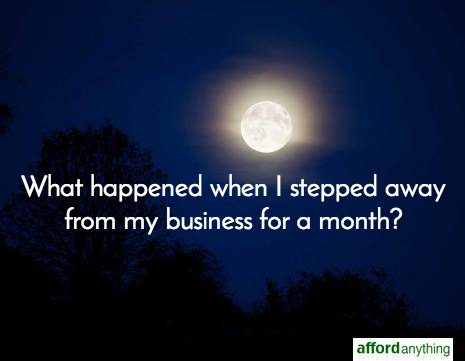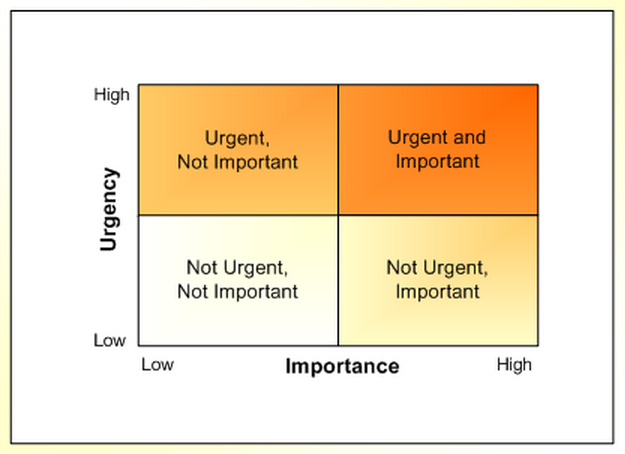
A few days ago, I slept in my own bed for the first time in more than a month.
I’ve been on the road nearly nonstop for the past few months — including trips to Costa Rica and Ireland — and the last 30 days really took the cake: from San Diego to New Orleans to Austin, I traipsed all across the U.S.
These trips were half-work, half-play.
I made speeches and presentations at a couple of conferences, met with a various bloggers, and participated in a few face-to-face mastermind groups. But I also went camping with friends, read loads of books, hiked, kayaked, paddleboarded, and generally soaked up each new location with gusto.
I’m now home for a solid two-and-a-half weeks. Then I fly to San Diego again (third trip this year!) to hit up a 4-day arts and music festival in the mountains.
Ay caramba.
The two obvious questions at this juncture are:
- How can you afford this? (Answered many times on this blog, including here, here and here).
- How do you balance this with your day-to-day workload?
Let’s tackle the second question.
I’m a digital nomad, which means I can work from my laptop from anywhere on the planet (as long as I have internet). But this doesn’t necessarily mean I WANT to be working 40-hour weeks while I travel.
On the contrary: I want to work As. Little. As. Possible. while I’m traveling. And for the past month, that’s exactly what I did.
(This is also why there’s been radio silence from this blog for a month. I needed a break from staring at a computer screen. I hope you understand. You can always find me on Facebook, Twitter and Instagram, where I whittle away far too much of my misspent youth.)
At any rate —
How did this one-month absence impact my income? Is my business ready for this level of passivity? And — most importantly — what lessons can I share that might benefit you?
Read on.
The Back Story
First, a bit of background:
As longtime Afford Anything Rebels already know, I quit my 9-to-5 job in 2008 and traveled for a couple of years, living on savings. When I came back to the U.S. in 2010, I began building an online business as a freelance writer and — later — as a content marketing consultant. (I also started investing in real estate, but that’s a different story for a different day).
Over the past four years, the digital business has grown from barely-eeking-out-an-existence to a healthy income. Like many stereotypical overworked solopreneurs, I initially handled everything myself. From operations to tech support to marketing to bookkeeping to design, I was a one-person machine.
I later woke up to the realization that if I want to build a lifestyle-centered enterprise, I needed to throw away the shackles of a “DIY” mentality. My goal is to have a business that works harder for me than I do for it. The most critical skill I can develop is hiring, training, promoting, and firing.
I started assembling a four-person, part-time team a little less than a year ago, with loads of trial, error, and mixed results. While I’m still a complete amateur at team leadership (seriously — I’m deep in the “still learning” phase), I’m light-years beyond my skill level from a mere 6 months ago.
(Moral of the story: Always be learning. “I don’t know how …” is never an excuse.)
This past month represented my first true test. Can I step away from my business for a month and leave it running as smoothly as it does when I’m behind-the-wheel?
The Experience
The test results are in. Here’s how it shook out:
Daily Operations:
This turned out to be 90 percent fine. My team was already in the habit of taking care of routine tasks, so my departure didn’t ruffle feathers in the least.
What about the problematic 10 percent? The core issue involved slow communication. When someone on my team emailed me a question, I would take about 3-4 days to respond — which would delay projects.
What triggered this problem? Their emails got buried in a sea of other unopened, unanswered email.
The solution? I began using a free Gmail feature called “Priority Inbox” that fixes this issue by automatically sending certain emails to the “priority” chain. (Note: This is different from Gmail’s “Primary” Inbox, which is automatically applied to all accounts.)
However, “Priority Inbox” wasn’t a complete cure. Some of their emails would still get swallowed by the general Inbox Monster. As a backup, I also instructed them to write the word “URGENT” (all-caps) in the subject line if they needed a response from me within the next 48 hours.
Meetings:
As a rule, I like to keep my calendar as clear as possible. Too many meetings are a waste of time. That said, on the rare occasions (maybe 1-2x/week) that I’d schedule a phone meeting, I found myself in ConfusionLand.
What triggered this problem? At home, I input everything into my calendar in Eastern Time. When I’m on the road, I’ll input it into my calendar in the local time of where ever I currently happen to be — which may or may not correspond to the time zone in which I’ll be located when I have the meeting. (Sometimes I don’t know have this information yet, since I’m not sure how long I’ll stay somewhere before moving onto the next spot.) And finally, sometimes the Google Calendar would automatically convert the meeting to the local time zone, but on occasion it wouldn’t, or something would get messed up, or perhaps I’d just get confused about the whole mess.
The solution? I began inputting every meeting in Eastern Time, so I would have a consistent “benchmark” for conversion. I also began manually writing the time — “4 p.m. Eastern” — in the event description. This way, if the scheduling auto-shifted on the calendar, I can still read the original benchmark. In the future, I’m contemplating using a more robust calendar program like ScheduleOnce, though I haven’t tried it yet. (That’s NOT an affiliate link; I don’t affiliate with anything unless I use it myself.)
New Business:
I’ll keep this one short: You can maintain your business while you step away … but you can’t grow it.
In one of my favorite books, 7 Habits of Highly Effective People, author Stephen Covey outlines the difference between “urgent” and “important” in your work life —

When you’re on cruise-control, you tend what’s “urgent” … not what’s “important.” That’s fine for a month or two. Just don’t make a habit of it (if you want to grow). 🙂
One unexpected benefit: Removing yourself clarifies what’s actually important vs. what’s just busy-work. (It also clarifies the areas in which you’re the bottleneck). You know the cliche: “Necessity is the mother of invention?” Turns out, necessity is also the mother of clarity.
Income:
Unchanged! No upset clients. No missed projects or deadlines. Everything ran as it did when I was back at home, despite working significantly fewer hours. (This makes me realize how — ahem — “unnecessary” I truly am). 🙂
We maintained the status quo quite nicely. We just didn’t make any growth progress, or chase any long-term prospects. That’s totally fine by me. I’m in this for the lifestyle.
Real Estate:
Having thoroughly tested a variety of real estate management tactics, I’m more convinced than ever that traditional rental properties are one of the BEST sources of truly passive income. (The initial phase is a pain-in-the-rear, but the aftermath is awesomesauce-with-a-side-of-hell-yeah.)
Meanwhile, vacation rentals (like being an AirBnb host) and active businesses (like my laptop-based operation) are more lucrative but require MUCH more time, energy and attention. One is a passive business, while the others are ultra-active.
Take-Away Lessons:
If you’re wondering how to apply this to your own life — even if you just want a 1-week getaway without needing to stay tethered to your email — here are some chief takeaways:
- Preparation is key. Start getting your systems in place months ahead of time.
- Eliminate, then automate, then delegate. It’s cliche because it’s true.
- Don’t over-optimize. Understand when “good enough” is good enough.
- Surround yourself with people who are smarter than you. And taller and better-looking. 🙂 Your team should pull you up, not tear you down. You’re a leader, not a babysitter.
- Make decisions based on simplicity. And let go of the details.
- Don’t live in your Inbox. Accept that sometimes, you’ll take weeks to answer non-critical emails. Your time and your mental bandwidth is limited, and you shouldn’t waste it wallowing in your Inbox. Finish your most critical work first, and indulge in email for dessert.
